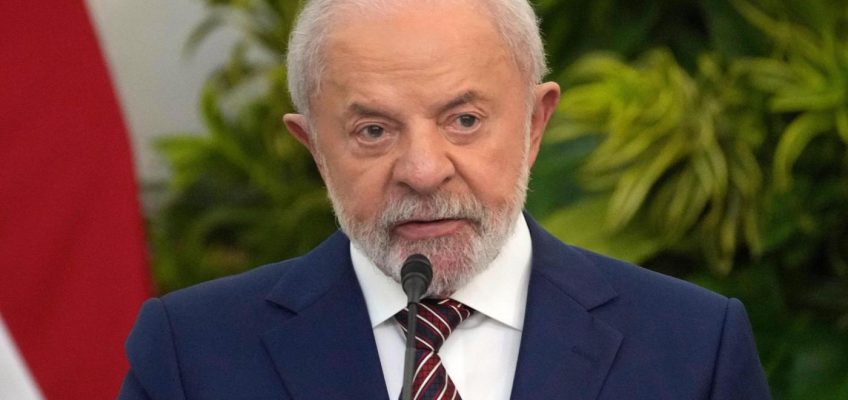By WYATTE GRANTHAM-PHILIPS and R.J. RICO
NEW YORK (AP) — Just days after a stunning heist at the Louvre Museum in Paris, speculation is growing around where the lavish, stolen jewels that once adorned France’s royals might end up.
China to focus on speeding up self-reliance in science and tech in new economic plan
King Charles III prays with pope in historic visit, a welcome respite from royal troubles at home
British ex-soldier acquitted of murder in 1972 Bloody Sunday massacre
One family fled Afghanistan. Then US deportations scattered them across the world
Trump mulls asking Israel to free Palestinian leader Barghouti as US looks to Gaza’s post-Hamas rule
A handful of experts warn that the artifacts valued at more than $100 million (88 million euros) could soon — if not already — be melted or broken into parts. If done successfully, some say those smaller pieces could later go up for sale as part of a new necklace, earrings or other jewelry, without turning too many heads.
“You don’t even have to put them on a black market, you just put them in a jewelry store,” said Erin Thompson, an art crime professor at the John Jay College of Criminal Justice in New York. “It could be sold down the street from the Louvre.”
Thompson and others say that this has become increasingly common with stolen jeweled and metal goods, noting that it’s a way thieves can try to cover their tracks and make money. It’s not like someone could publicly wear one of France’s Crown Jewels stolen on Sunday — and finding a market to sell the full artifacts would be incredibly difficult after “everyone and their sister” has seen photos of them over the last week, said Christopher Marinello, a lawyer and founder of Art Recovery International.
The jewels may be hard to monetize
“By breaking them apart, they will hide their theft,” Marinello said, adding that these items could become even more “traceless” if they’re taken out of France and through jewel cutters and robust supply chains in other countries.
Still, such pieces are often sold for a fraction of the value of what was stolen — due to their smaller size, but also because melting or breaking down high-profile items removes the historical worth.
It isn’t a simple process.
“The real art in an art heist isn’t the stealing, it’s the selling,” explained Robert Wittman, former senior investigator of the Federal Bureau of Investigation’s art crime team. Wittman, who has since formed his own private practice, said that the individuals behind such heists are typically “better criminals or thieves than they are businessmen.”
Unlike others, Wittman is skeptical about Sunday’s thieves successfully monetizing the artifacts they stole from the Louvre — which include an emerald necklace and earrings, two crowns, two brooches, a sapphire necklace and a single earring worn by 19th-century royals. He notes the gems may still be identifiable by their clarity, for example, and gold that was refined when the pieces were made hundreds of years ago is not as pure as what’s typically in demand today.
Visitors walk in the lobby of the Louvre museum three days after historic jewels were stolen in a daring daylight heist, Wednesday, Oct. 22, 2025 in Paris. (AP Photo/Thibault Camus)
“Because of what they are, there’s really no point destroying them,” Wittman said, while pointing to the risks of selling such high-profile stolen goods.
Scott Guginsky, executive vice president of the Jewelers’ Security Alliance, a nonprofit trade association focused on preventing jewelry crime, also notes the age and quality of the artifacts’ diamonds. He suspects they’re probably not graded.
“It’s not something that you can move on the open market. It’s nothing that can go through an auction house,” said Guginsky, who used to run the New York Police Department’s organized theft squad.
Given the amount of preparation that the thieves likely put into this, Guginsky believes they have a plan for selling the jewels, even if they might first decide to “sit on” the jewelry and wait out suspicion.
“I can’t see them stealing it without having an idea what they want to do,” he said. “There’s always a person willing to buy stolen jewelry. No matter what it is, somebody will buy it.”
Sara Yood, CEO and general counsel of the Jewelers Vigilance Committee, notes most jewelry businesses implement anti-money laundering programs and look out for red flags like unusual orders, repeated purchases and requests for secrecy.
Still, she and others say the age of some jewels — if broken down effectively — could actually make it harder to track. Newer gemstones, for example, sometimes carry a laser inscription inside that can be evaluated in a lab. But “because these are historical pieces, it’s rather unlikely that it has those identifying features,” noted Yood.
Experts like Thompson say bigger gems can be recut to a point that they’re unrecognizable. A challenge is finding people who have the skill to do that and don’t ask too many questions — but it’s possible, she said.
Whether the people behind Sunday’s heist had those contacts or certain buyers lined up is unknown. But it’s important to also note that “the guys who actually enter the museums are usually all hired hands, and they’re almost always caught in these cases,” Thompson added.
Chances of recovery look dim
She and others say that museums have increasingly faced a rash of similar thefts over recent years. Thompson notes that stealing from storage can go undetected for longer: the British Museum in London, which has accused a former curator of stealing artifacts and selling them online, is still trying to recover some of the 2,000 items stolen.
Some past thieves have made ransom demands for stolen artwork overall, or wait for a potential “no questions asked” reward from an insurance company — which can amount to about a 10% cut for some insured pieces in Europe, Thompson says. The jewels stolen from the Louvre Sunday, however, were reportedly not privately insured.
Sometimes government offers of a reward for information about a high-profile heist can also quicken the investigation, although the French government has yet to publicize such an incentive. If that changes, or promising leads are uncovered from the evidence left behind at the Louvre, experts like Wittman note it could increase the chances of recovering the artifacts.
Still, as more time passes, others feel that the fate of finding the historic jewels looks dim.
“I think they’re going to catch the criminals,” said Marinello. “But I don’t think they’ll find them with the jewels intact.”
Rico reported from Atlanta.




